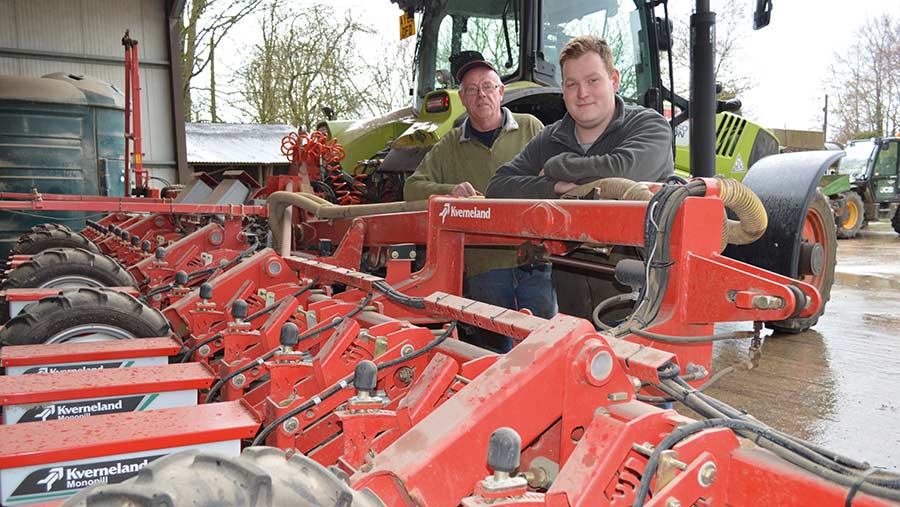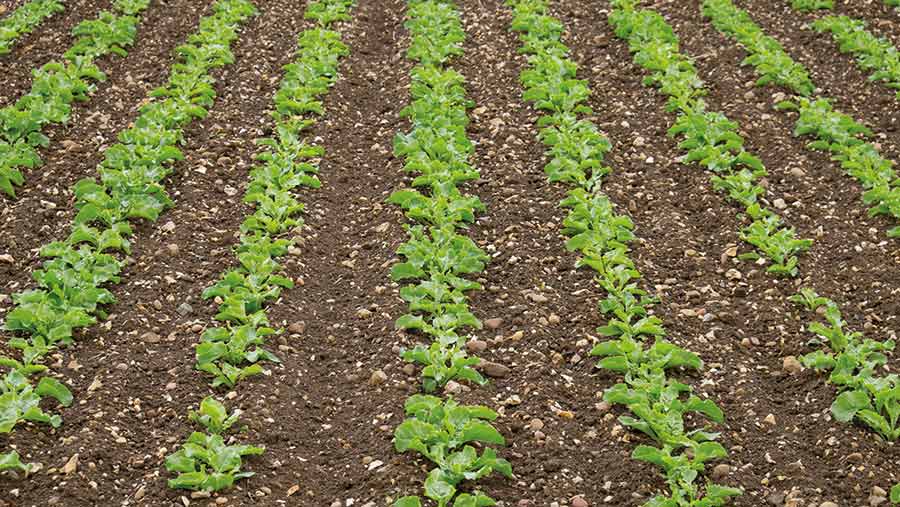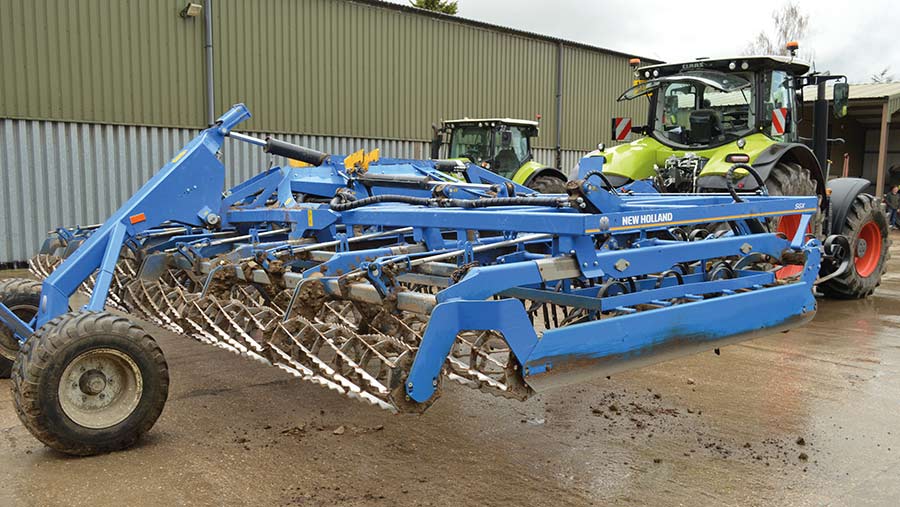Video: Sugar beet growers set for April rush to get crop drilled
 Adam and Tom Rayner © MAG/David Jones
Adam and Tom Rayner © MAG/David Jones Sugar beet growers are set to have a busy Easter as better forecast weather will see them trying to catch up on beet drilling, with only 5% of the national crop drilled in the wettest March in England for more than 40 years.
See also: What the neonics authorisation means for sugar beet growers
Cambridgeshire father-and-son growers Adam and Tom Rayner did not sow a single beet seed during March, putting them behind with their plan to drill 400ha of sugar beet this season on their chalky loamy soils.
Adam Rayner says he has never drilled as late as this in his working lifetime, but he is still confident about the crop’s prospects, as the beet price has doubled this season and there is a seed dressing available to control virus yellows disease.
“As long as we get the crop drilled by the end of the second week of April we should be OK. With nine to 10 days of good weather we could well be finished,” he tells Farmers Weekly.
Farm facts
David Rayner Farms, Burgh Hall, Swaffham Bulbeck, Cambridgeshire, crops 1,200ha, including winter wheat, winter barley, spring oats, peas and sugar beet.
No concern at the moment
The family-run 1,200ha arable business at Burgh Hall, Swaffham Bulbeck, between Cambridge and Newmarket, is not an early-drilling sugar beet farm – sowing never starts until 15 March.
All beet is delivered to the local factory at Bury St Edmunds in Suffolk.
“It’s not a concern at the moment, and prospects look good with prices where they are for this season. It’s not when you start drilling, it’s when you finish that’s important,” says Mr Rayner.
Spring-drilling growers have suffered in the wettest March in England since 1981 – rainfall in the Cambridge area during March has been more than three times the average.
Yield potential
Nick Morris, head of central agriculture at British Sugar, says yield potential can be lost when drilling after the first week in April, but adds that the key factor is to get the crop well established into warm and moist soils.
“In theory, some yield could be lost, but conditions are more important. It is better to drill later into good conditions than to drill early into bad conditions,” he says.

© Tim Scrivener
This March only the very lightest land in the Norfolk/Suffolk Brecklands, Nottinghamshire sandlands and Lincolnshire heathland has been drilled, leaving 95% of the nation’s sugar beet crop to be drilled during April.
Beet processor British Sugar forecasts that the sugar beet area grown by more than 3,000 English growers will be up about 10% this season at 95,000-100,000ha, compared with a 88,000ha crop in the 2022 growing season.
Beet area
Mr Rayner is not increasing his sugar beet area this spring for rotational reasons.
He is growing 180ha on his own land, 60ha on contracted farms, 32ha for British Sugar and the rest is contract sowing work for neighbouring farms.
His land, which straddles the A14 trunk road, produces high yields of beet.
The five-year average is well above 80t/ha, but yields fell by about 35% last year due to the prolonged summer drought and beet moth attacks.
His farm was one of the first to spot the pest attacks in early July.
Last season was a low point for the sugar beet industry, with average yields hit by the dry weather and then by severe frosts over the winter months.
British Sugar cut its white sugar forecast for the 2022 crop in late January 2023 to 0.74m tonnes – down from 0.9m tonnes previously and a drop from the 1.03m tonnes produced in the 2021 growing year.
For this season, like in 2022, the use of neonicotinoid insecticide seed dressings have been given the green light for emergency use to control peach-potato aphids (Myzus persicae), which spread virus yellows.
The seed treatment should give 10 weeks of protection from aphids, taking the crop to the 12-leaf stage in June, when plants become more resistant to the disease.

© MAG/David Jones
Seed dressing
Mr Rayner is set to use the approved Cruiser (thiamethoxam) neonicotinoid seed dressing on 80% of his planned area, and Mr Morris says the uptake of this dressing is likely to be less than the 70% seen nationwide last season.
Neonicotinoid seed treatments were banned for use in sugar beet in 2018 due to concerns that they may kill bees and other pollinations, and they were not used on the crop in 2019, 2020 and 2021.
However, emergency use was authorised in 2022 and again in 2023 due to the high risk of the disease.
The threat from aphid-borne virus yellows disease is monitored by Rothamsted Research.
It assessed that the risk was high enough on 1 March to give the go-ahead for neonicotinoid dressing to be used in 2023.
A heavy infestation of virus-carrying aphids occurred in 2020, leading to a sharp 25% fall in national sugar beet yields.
Some growers prefer not to use the dressing, as the emergency use stipulates that no openly flowering crops can be grown in the next 32 months after the beet is drilled.
These include crops such as oilseed rape, peas, beans and some cover crops.
Fair weather
Mr Rayner is ready for dry weather, with all his sugar beet land winter ploughed. After one or two passes with a cultivator, he will be ready to sow beet with his 18-row Kverneland precision drill.
At least one of his contracted farms has taken up the early-lifting one-off contract to deliver beet to the local Bury St Edmunds factory from 4-13 September for a guaranteed return of £3,000/ha.
This offer covering 1,400ha was quickly snapped up by Bury growers.
The guaranteed return of £3,000/ha adds up to being paid for an equivalent yield of 75t/ha at £40/t, whatever the actual harvested yield.
The aim is to start the harvest early this year to make up for low stocks from the poor sugar beet crop in 2022.
Bury is British Sugar’s second-largest factory, processing 14-15,000t of beet a day – less than Wissington in west Norfolk at 18,000-19,000t, but more than Newark in Nottinghamshire and Cantley in east Norfolk.
Cantley is set to start processing again this autumn after missing most of the 2022-23 processing season.
The plant opened for deliveries in October 2022, but structural damage to its lime kiln hopper caused the factory to be closed down in December, and local beet was diverted to Wissington and Bury.
UK sugar beet harvests |
|||
| Year | White sugar production | Average beet yield | Sugar beet area |
| 2019 | 1.19m tonnes | 80.65t/ha | 100,000ha |
| 2020 | 900,000t | 59.15t/ha | 103,000ha |
| 2021 | 1.03m t | 81.1t/ha | 91,000ha |
| 2022 | 740,000t | 64.0t/ha | 88,000ha |
| 2023 | n/a | n/a | 95,000-100,000ha |
| The five-year average national beet yield is 71.5t/ha. The record crop of 1.45m tonnes of white sugar was harvested in 2014. | |||

